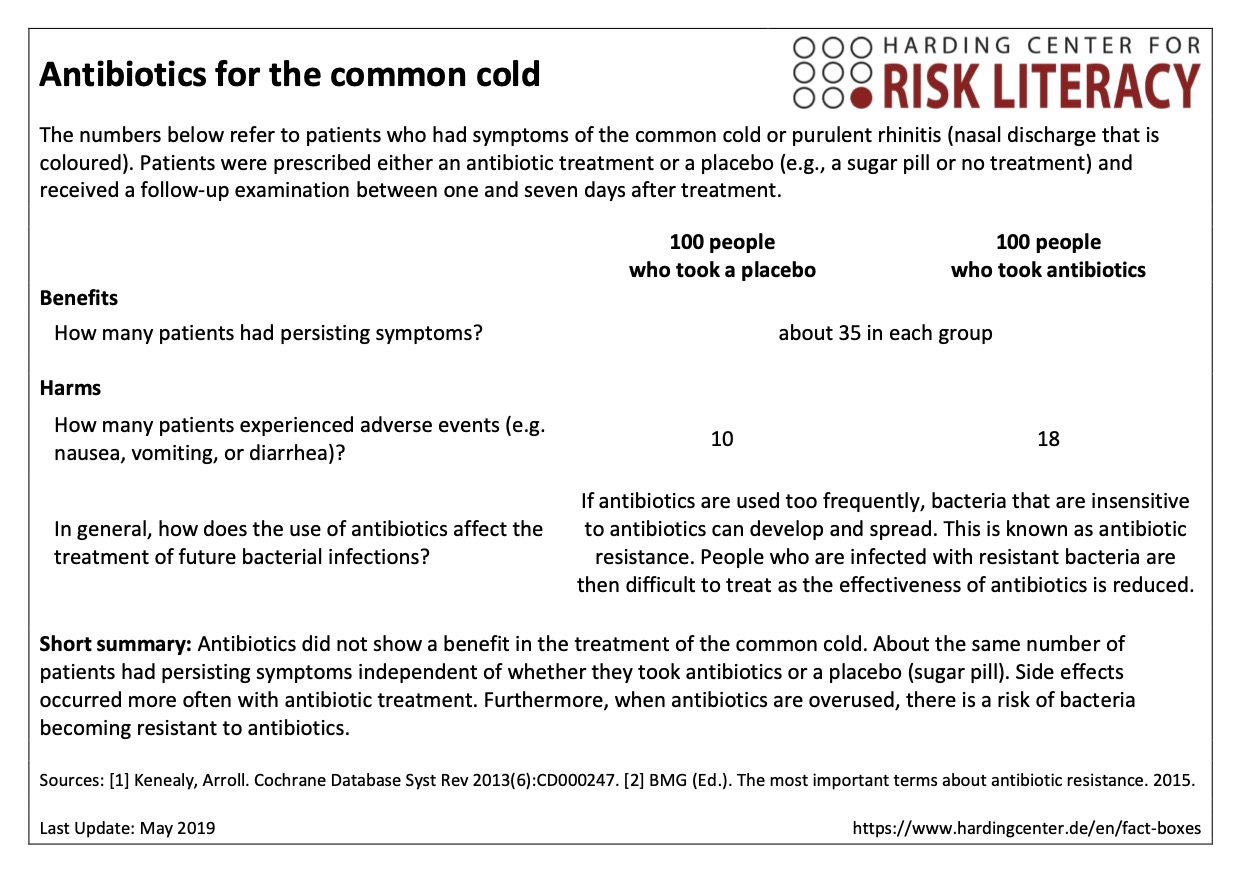This fact box will help you to weigh the benefits and harms of antibiotics for the common cold. The information and numbers are based on the best scientific evidence currently available.
This fact box was developed by the Harding Center for Risk Literacy.
Colds are very common, particularly among children. It is quite normal for children to catch six to ten colds per year at school or daycare. Adults experience two to four colds a year on average, mainly during the colder months [2].
A cold is a virus that often starts with a scratch or tickle in the throat, followed by a runny or blocked nose. Normally, the immune system is able to fight the infection without any difficulties[2]. However, a cold can sometimes develop to include fever or a prolonged cough.
Antibiotics are among the most important drugs in the treatment of infectious diseases. They are effective at treating bacterial infections but ineffective at treating viruses.
By targeting all bacteria, antibiotics can also have a negative effect on naturally occurring bacteria, such as those in the intestine. As a result, antibiotics may cause diarrhea and nausea. In addition, some people may experience an allergic reaction. Overuse of antibiotics leads to bacteria becoming resistant to them [1].
Children and adults who experience a secondary bacterial infection may consider antibiotic treatment [2].
An alternative is to rest, consume plenty of fluids, and wait for symptoms to disappear. Painkillers, fever-reducing drugs, or expectorants can be used to alleviate symptoms.

The fact box shows the benefits and harms of antibiotics compared with a placebo for treatment of the common cold.
The table may be read as follows:
35 out of every 100 patients had persisting symptoms one to seven days after treatment, independent of whether they took antibiotics or a placebo (sugar pill).
The numbers in this fact box are rounded. They are calculated from 11 studies that included a total of about 1,050 participants [1].
If antibiotics are used too frequently, bacteria that are insensitive to antibiotics can develop and spread. This is known as antibiotic resistance. People who are infected with resistant bacteria are then difficult to treat as the effectiveness of antibiotics is reduced.
Do the results provide proof (evidence) for the benefits and harms of treatment with antibiotics for common cold?
Overall, the evidence is of high quality. It is very unlikely that further research will change the results [1].
- May 2019 (update of the literature research, no new evidence)
- December 2017 (update of the evidence)
- February 2014 (development)
Information within the fact box was obtained from the following sources:
[1] Kenealy T, Arrol B. Antibiotics for the common cold and acute purulent rhinitis. Cochrane Database Syst Rev 2013(6) doi: 10.1002/14651858.CD000247.pub3.
[2] IQWiG. Common Cold 2017. [www.informedhealth.org/common-colds.2642.en.html] 01.12.2017.
[3] BMG. Die wichtigsten Begriffe zum Thema Antibiotika-Resistenzen 2019. [https://www.bundesgesundheitsministerium.de/themen/praevention/antibiotika-resistenzen/die-wichtigsten-begriffe.html] 04.05.2019.
Documentation on how the numbers in the fact box were determined is available on request.
